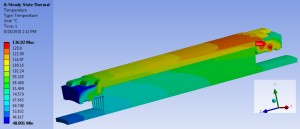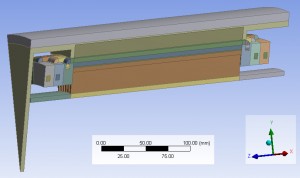High Speed / High Power Density Air-Core Electrical Machine Design – Thermal Management
High Speed / High Power Density Air-Core Electrical Machine Design – Thermal Management
MSEE student Xuan Yi with Adviser K. Haran
The goal of this high-speed electrical machine project is to build a permanent magnet machine with a power density of 13 KW/kg (8hp/lb) and over 96% efficiency under rated condition. The targeted power density is twice or three times larger than the power density of usual electrical machines. This is achieved by utilizing a high frequency air-core armature that is in intimate contact with heat fins within the self-contained machine. The fins will be cooled with high-velocity forced air pumped by vanes on the rotor end plates. High power density and high speed in an electrical machine involve a tremendous amount of heat generated both by the high current density and windage and iron losses. Effective thermal management to direct the heat loss outside the machine is required to secure that the machine operates at a safe temperature. A steady-state thermal analysis uses ANSYS (finite element analysis) to estimate temperature distribution in a 3-D machine model given in Figure 1. Current results show that both rotor and stator hotspot temperatures are within the material temperature limitations. Figure 2 presents a detailed stator temperature distribution with the thermal fin dimension optimized. Future research will focus on model verification through real experiments and fluid analysis. This work was supported by NASA Grant Number: NNX14AL79A and the Grainger Center for Electric Machinery and Electromechanics.

